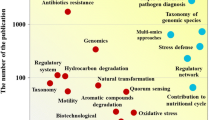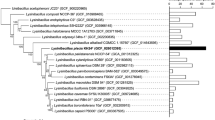Abstract
A new species of extremely thermophilic, glycolytic anaerobic bacterium, Fervidobacterium nodosum isolated from a New Zealand hot spring, is described. Fervidobacterium nodosum strains were Gram-negative, motile, non-sporulating obligately anaerobic rods that existed singly, in pairs or in chains. Electron micrographs of thin sections revealed a two-layered cell wall structure. The outer layer of the cell wall produced “spheroids”, which was a typical feature of this organism. The optimum temperature for growth was 65 to 70° C, the maximum 80° C and the minimum greater than 40° C. Growth occurred between a pH of 6.0 and 8.0 with the optimum being 7.0 to 7.5. The doubling time of Fervidobacterium nodosum at optimal temperature and pH was 105 minutes. The DNA base composition was 33.7% guanine plus cytosine as determined by thermal denaturation. A wide range of carbohydrates including glucose, sucrose, starch and lactose could be utilized by the organism. Lactate, acetate, hydrogen, and carbon dioxide were the major end products of glucose fermentation with lesser amounts of ethanol being formed. Growth was inhibited by tetracycline, penicillin and chloramphenicol indicating that the organism was a eubacterium.
Similar content being viewed by others
References
Ben-Bassat A, Zeikus JG (1981) Thermobacteroides acetoethylicus gen. nov. and spec. nov., a new chemoorganotrophic, anaerobic thermophilic bacterium. Arch Microbiol 128:365–370
Brock TD, Freeze H (1969) Thermus aquaticus gen. nov. and spec. nov., a non-sporulating extreme thermophile. J Bacteriol 98:289–297
Gibson DM, Ogden ID (1979) A rapid method for purifying bacterial deoxyribonucleic acid. J Appl Bacteriol 46:421–423
Hollaus F, Sleytr U (1972) On the taxonomy and fine structure of some hyperthermophilic saccharolytic clostridia. Arch Mikrobiol 86:129–146
Hungate RE (1950) The anaerobic mesophilic cellulolytic bacteria. Bacteriol Rev 14:1–9
Klaushofer H, Parkkinen E (1965) Zur Frage der Bedeutung aerober und anaerober thermophiler Sporenbildner als Infektionsursache in Rübenzucker-Fabriken I. Clostridium thermohydrosulfuricum, eine neue Art eines Saccharose abbauenden, thermophilen, Schwefelwasserstoff bildenden Clostridiums. Zuckerind 15:445–449
Latham MJ, Wolin J (1978) Use of a serum bottle technique to study interactions between strict anaerobes in mixed culture. In: Lovelock ON, Davies R (eds) Techniques for the study of mixed population, Soc Appl Bacteriol technical series 11, Academic Press, London New York, pp 113–124
Marmur J (1961) A procedure for the isolation of deoxyribonucleic acid from microorganisms. J Mol Biol 3:208–218
Owen RJ, Hill LR (1979) The estimation of base compositions, base pairing and genome sizes of bacterial deoxyribonucleic acids. In: Skinner FA, Lovelock DN (eds) Identification methods for microbiologists. Soc Appl Bacteriol technical series 14, Academic Press, London New York, pp 277–296
Patel BKC (1984) Extremely thermophilic bacteria in New Zealand hot springs. Ph. D. thesis, University of Waikato, Hamilton, New Zealand
Pheil GC, Ordal ZJ (1967) Sporulation of the “thermophilic anaerobes”. Appl Microbiol 15:893–898
Schink B, Zeikus JG (1983) Clostridium thermosulfurogenes sp. nov., a new thermophile that produces elemental sulphur from thiosulphate. J Gen Microbiol 129:1149–1158
Sleytr UB, Glauert AM (1976) Ultrastructure of the cell walls of two closely related clostridia that possess different regular arrays of surface subunits. J Bacteriol 126:869–882
Spurr AR (1969) A low viscosity epoxy resin embedding medium for electron microscopy. J Ultrastr Res 26:31–43
Stephen H, Stephen T (1963) Solubilities of inorganic and organic compounds. Pergamon Press, London
Wiegel J, Ljungdahl LG (1981) Thermoanaerobacter ethanolicus gen. nov, spec. nov., a new, extreme thermophilic, anaerobic bacterium. Arch Microbiol 128:343–348
Wiegel J, Ljungdahl LG, Rawson JR (1979) Isolation from soil and properties of the extreme thermophile Clostridium thermohydrosulfuricum. J Bacteriol 139:800–810
Wolin EA, Wolin MJ, Wolfe RS (1963) Formation of methane from bacterial extracts. J Biol Chem 238:2882–2886
Zeikus JG, Hegge PW, Anderson MA (1979) Thermoanaerobium brockii gen. nov. and spec. nov., a new chemoorganotrophic, caldoactive, anaerobic bacterium. Arch Microbiol 122:41–48
Zeikus JG, Ben-Bassat A, Hegge P (1980) Mibrobiology of Methanogenesis in thermal volcanic environments. J Bacteriol 143:432–440
Zillig W, Gierl A, Schreiber G, Wunderl S, Janekovic D, Stetter KO, Klenk HP (1983) The archaebacterium Thermofilum pendens represents a novel genus of the thermophilic, anaerobic sulfur respiring Thermoproteales. System Appl Microbiol 4:79–87
Zillig W, Stetter KO, Schäfer W, Janekovic D, Wunderl S, Holz I Palm P (1981) Thermoproteales: A novel type of extremely thermoacidophilic anaerobic archaebacterium isolated from Icelandic solfataras. Zbl Bakt Hyg 1 Abt Orig C 2:205–227
Author information
Authors and Affiliations
Rights and permissions
About this article
Cite this article
Patel, B.K.C., Morgan, H.W. & Daniel, R.M. Fervidobacterium nodosum gen. nov. and spec. nov., a new chemoorganotrophic, caldoactive, anaerobic bacterium. Arch. Microbiol. 141, 63–69 (1985). https://doi.org/10.1007/BF00446741
Received:
Accepted:
Issue Date:
DOI: https://doi.org/10.1007/BF00446741




